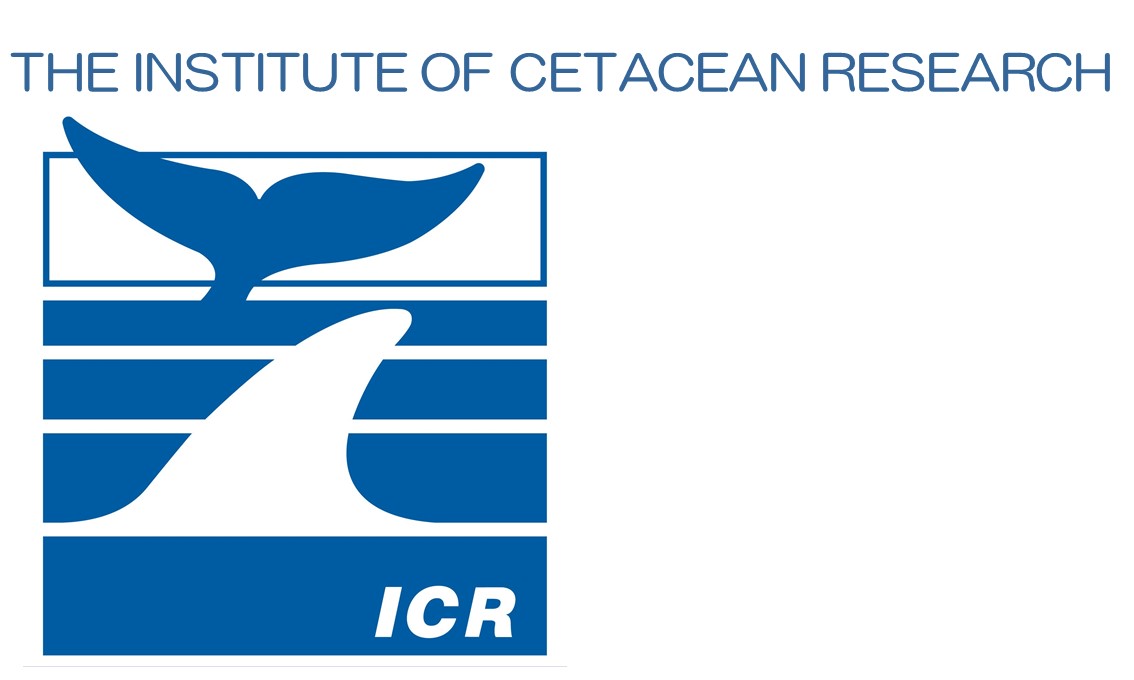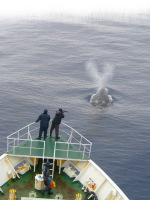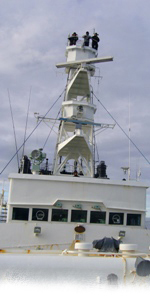- You are here:
- Home>
- English Sitemap>
- RESEARCH>
- Past Research>
- Western North Pacific>
- JARPN II
JARPNII outline
There were two pillars in the construction of JARPNII by the Institute of Cetacean Research (ICR), both based on their findings from JARPN: (1) to contribute to fisheries management in the western North Pacific using ecosystem approaches (e.g. building ecosystem models); and (2) to contribute to the conservation and management of whale resources in the western North Pacific and especially via the RMP Implementation process.
With respect to the first, the western North Pacific supports a vast amount of marine living resources including zooplankton, schooling fishes, oceanic squids, seabirds and cetaceans. It is also a major fishing ground for Japan and other coastal countries. The sustainable use of marine living resources in the region requires an ecosystem approach. This includes collecting data and building ecosystem models that take account interactions between marine mammals and fisheries.
Objectives
Objective1
Feeding ecology and ecosystem studies
This was the top priority research objective of the program and included investigations on (a) prey consumption and prey preferences of cetaceans and (b) ecosystem modeling.
The original JARPNII research plan identified a number of questions.
(1) How does the consumption of species targeted by commercial fisheries compare to the catches themselves?
(2) Does the consumption by cetaceans have a significant impact on natural mortality and recruitment of prey?
(3) Does the abundance and distribution of the prey species affect the migration pattern, recruitment and geographical segregation by sex of cetaceans?
(4) Is there direct and/or indirect competition among cetaceans and between cetaceans and other top predators such as fur seals, tunas and sharks?
JARPNII attempted to address these questions (see figure below) through a number of sub-objectives related to: oceanographic studies; distribution and abundance of large whales and potential drivers; prey consumption by cetaceans; potential impact of cetacean consumption on commercial fisheries; prey abundance; prey preferences of cetaceans; feeding habits and associated ecology; annual trends in cetacean body condition; development of inshore and offshore ecosystem models.
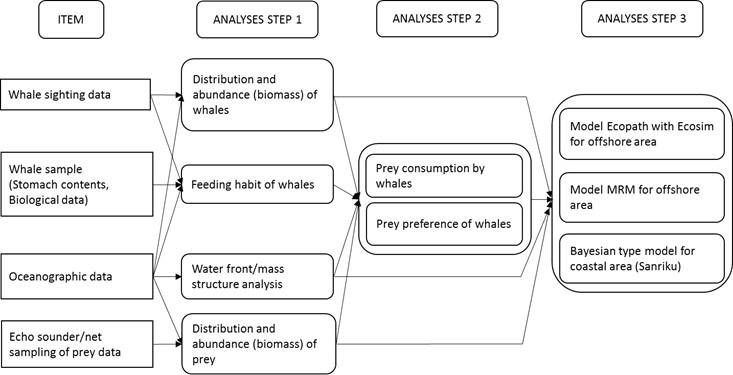
One of the ultimate goals of JARPNII under Objective 1 was to contribute to the conservation and sustainable use of all marine living resources in the western North Pacific, especially within Japan’s EEZ. JARPNII was expected to contribute via the development of several ecosystem models.
Objective 2
Monitoring environmental pollutants in cetaceans and the marine ecosystem
Since the 1990’s, there were increasing concerns of the potential negative effects of chemical pollutants at the population level. Those concerns were echoed at the IWC, who passed several resolutions on the need for research on chemical pollutants and the effect on the health of cetaceans. ICR developed a second objective of JARPNII in response to these.
Objective 2 had three sub-objectives i.e. to study:
(1) the pattern of accumulation of pollutants in cetaceans;
(2) the bioaccumulation process of pollutants through the food chain;
(3) the relationship between chemical pollutants and cetacean health.
The figure below shows a schematic representation of the components of Objective 2.
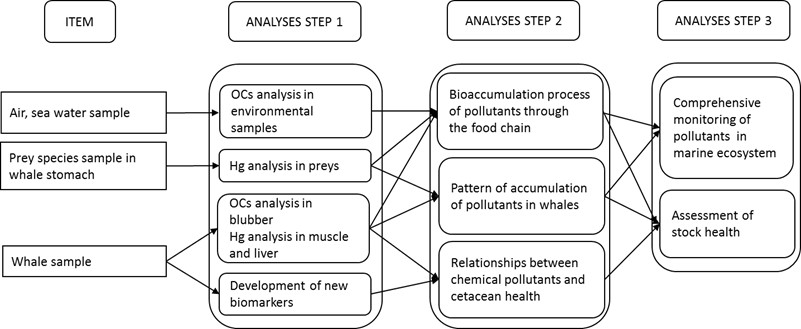
Objective 3
Stock structure of large whales
The importance of stock structure information has been discussed previously. In the case of JARPNII, the focus was on common minke and Bryde’s whales (RMP ISTs) and in-depth assessments on other large whale species, especially sei whales. ICR included several sub-objectives in response to stock structure questions posed by the IWC SC on the above three species in the region. The figure below shows a schematic representation of the components of Objective 3.

Research area and period
JARPNII took place in spring-summer. It was initially designed by ICR as a long-term research program of undetermined duration, to be reviewed by the IWC SC every six years. In practice it was conducted between 2000 and 2016 (17 years), with the first two years carried out as a feasibility study to examine the practicability of concurrent whale and prey surveys. Sub-areas 7, 8, 9 in the figure below were covered by JARPNII surveys.
JARPNII had a coastal component (Sanriku, sub-area 7CS; Kushiro, sub-area 7CN in the figure below), and an offshore component (the rest of sub-area 7 and sub-areas 8 and 9 in the figure below). Different sub-areas were covered in different years based on the objectives and sub-objectives of the research program.
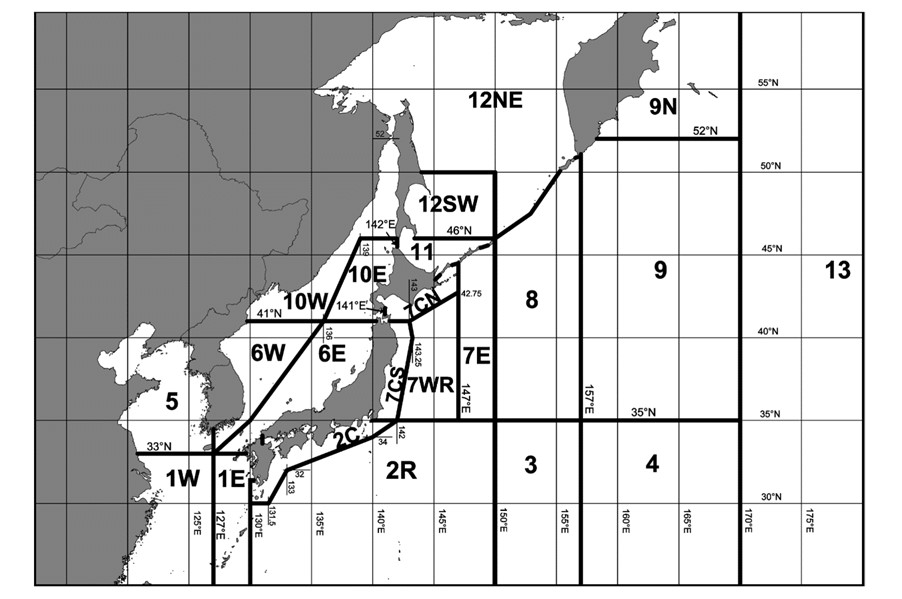
One of the strengths of JARPNII was the inclusion of concurrent whale and prey surveys in the offshore component in some years of the program to investigate prey selectivity by whales. The two-year feasibility surveys were mainly dedicated to examining the feasibility and practicability of the concurrent surveys.
Sample sizes and actual catches
The annual sample sizes and the actual catches of JARPNII are shown in the table below.
| Year | Common minke whale | Bryde’s whale | Sei whale | Sperm whale | ||||
| Sample size | Catches | Sample size | Catches | Sample size | Catches | Sample size | Catches | |
| 2000(F) | 100 | 40 | 50 | 43 | 0 | - | 10 | 5 |
| 2001(F) | 100 | 100 | 50 | 50 | 0 | - | 10 | 8 |
| 2002 | 150 (100 O; 50 C*) | 150 (100 O; 50CN) | 50 | 50 | 50 | 39 | 10 | 5 |
| 2003 | 150 (100 O; 50C*) | 150 (100 O; 50CS) | 50 | 50 | 50 | 50 | 10 | 10 |
| 2004 | 220 (100 O; 120C) | 159 (100 O; 59CN) | 50 | 50 | 100 | 100 | 10 | 3 |
| 2005 | 220 (100 O; 120C) | 220 (100 O; 60CN; 60CS) | 50 | 50 | 100 | 100 | 10 | 5 |
| 2006 | 220 (100 O; 120C) | 195 (100 O; 35CN; 60CS) | 50 | 50 | 100 | 100 | 10 | 6 |
| 2007 | 220 (100 O; 120C) | 207 (100 O; 50CN; 57CS) | 50 | 50 | 100 | 100 | 10 | 3 |
| 2008 | 220 (100 O; 120C) | 169 (59 O; 50CN; 60CS) | 50 | 50 | 100 | 100 | 10 | 2 |
| 2009 | 220 (100 O; 120C) | 162 (43 O; 59CN; 60CS) | 50 | 50 | 100 | 100 | 10 | 1 |
| 2010 | 220 (100 O; 120C) | 119 (14 O; 60CN; 45CS) | 50 | 50 | 100 | 100 | 10 | 3 |
| 2011 | 220 (100 O; 120C) | /126 (49 O; 60CN; 17CS) | 50 | 50 | 100 | 95 | 10 | 1 |
| 2012 | 220 (100 O; 120C) | 182 (74 O; 48CN; 60CS) | 50 | 34 | 100 | 100 | 10 | 3 |
| 2013 | 220 (100 O; 120C) | 95 (3 O; 58CN; 34CS) | 50 | 28 | 100 | 100 | 10 | 1 |
| 2014 | 114 (C)** | 81 (51CN; 30CS) | 50*** | 25 | 100**** | 90 | 10 | - |
| 2015 | 114 (C)** | 70 (51CN; 19CS) | 50*** | 25 | 100**** | 90 | 10 | - |
| 2016 | 114 (C)** | 48 (32CN; 16CS) | 250*** | 25 | 100**** | 90 | 10 | - |
F: feasibility studies.
O: Offshore component.
C: Coastal component.
CN: Coastal component off Kushiro.
CS: Coastal component off Sanriku.
*: 50 common minke whales as feasibility study of the coastal component.
**: Number of whales taken in the coastal component. Of these, 12 were studied by non-lethal means.
***: Of these, 25 were studied by non-lethal means.
****: Of these, 10 were studied by non-lethal means.
The species and numbers taken specified in the 2000 plan for the offshore feasibility study were: common minke whale (n=100); Bryde’s (n=50); and sperm (n=10). For the full program in 2002, 50 sei whales for the offshore component and 50 common minke whales for the coastal component (as a two-year (2002-2003) feasibility study) were added. For the 2004 revised plan the species and numbers were: common minke whales (n= 220 - 100 offshore and 120 coastal); Bryde’s (n=50); sei (n=100); and sperm (n=10).
In 2014, after the International Court of Justice (ICJ) Judgement on the case ‘Whaling in the Antarctic’, the Government of Japan (GOJ) introduced the following changes to the 2014 JARPNII: (1) no sperm or common minke whales would be taken as part of the offshore component and the number of common minke whales to be taken in the inshore component was reduced from 120 to 114; and (2) feasibility studies of non-lethal techniques would commence with 12 common minke, 25 Bryde’s and 10 sei whales being simultaneously studied using non-lethal techniques (see table above).
Review of JARPNII research proposal and results
The original research plan for the first two years of feasibility surveys of JARPNII was presented to the IWC SC meeting in 2000 (Doc. SC/52/O1). The full research plan was presented to the IWC SC meeting in 2002 (Doc. SC/54/O2). A revised research plan of JARPNII was presented to the IWC SC meeting in 2004 (Doc. SC/56/O1) together with an additional document with results of the feasibility component of the plan presented in 2002 (Doc. SC/56/O2) The IWC SC reviewed and commented the proposals and plans using the ‘Old Review Procedure’.
Under this procedure,review of proposals and results took place either during the annual meetings of the IWC SC or by holding intersessional review meetings or workshops open to participation by scientists from all Contracting Governments as well as invited participants.
The IWC SC carried out review workshops to review JARPNII results in 2009 (mid-term review) and 2016 (final review), using the ‘New Review Procedure’ (see table below).
This new procedure was developed by the IWC SC in 2008 to increase the level of consensus.The most important component if the new procedure was an Expert Panel workshop,with specific Terms of References for both review of new proposals and review of research results from existing and completes special permit research programs.The workshops had open and closed sessions and scientists from the Contracting Government participated only in the open sessions to present research proposal and results,and to answer points of clarification from the Panel.
| JARPNII | ||
| 2009 (Existing) | 2016 (Completed) | |
| Date | 26-30 January | 22-26 February |
| Place | Yokohama | Tokyo |
| Chair | Arne Bjorge (Norway) | Caterina Fortuna (Italy) |
| No. international Review Panel | 14 (Norway, South Africa, Germany, IWC Secretariat, UK, USA, Sweden, Japan) | 14 (Spain, IWC Secretariat, UK, Italy, USA, Canada, Norway, Japan, Netherlands, Germany) |
| No. Japanese proponents* | 16 | 23 |
| No. observers* | 0名 | 3 (Australia, Norway, South Africa) |
| No. primary documents by proponents/td> | 36 | 57 |
| No. other documents** | 0 | 1 |
| No. response documents by proponents*** | 0 | 1 |
| For Information documents | 12 | 37 |
| Reference | IWC, 2010 pp 405 | IWC, 2017 pp527 |
*: proponents and observers participated only in the open sessions of the workshop, i.e., not in Panel discussions and deliberations.
**: documents prepared by Review Panel members and observers.
***: documents prepared by the proponents in response to documents prepared by observers.
There was a comprehensive sample and data set obtained by JARPNII (IWC, 2017, pp590).
The JARPNII program started in 2000 as a two-year feasibility survey. The full program started in 2002 as a long-term research program of undetermined duration.
It was halted, however, in 2016. The top priority research objective was on feeding ecology and ecosystem studies in the Pacific side of Japan.
Other objectives were the monitoring environmental pollutants in cetaceans and the marine ecosystem, and stock structure of large whale species.
The target species for the lethal sampling were the common minke, Bryde’s, sei and sperm whales and the annual sample sizes were 220, 50, 100, and 10, respectively.
JARPNII proposal and results were duly reviewed and commented by the IWC SC through specific workshops.
